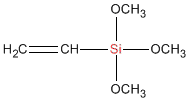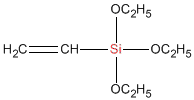- Polymer Manufacturing (Silane Donors for Polypropylene Catalysts)
- Engineering Plastic (Siloxane Masterbatch & Powder)
- High Performance Plastic / Filled Plastic (Thermosets)
- Silane Crosslinking PE (XLPE)
- Silane Crosslinking PE (XLPE)
Silane Crosslinking PE (XLPE)
Vinyl silanes have been used commercially since the 1970s to crosslink polyethylene homopolymer and its copolymers. SiSiB® PC6110 (Vinyltrimethoxysilane) and SiSiB® PC6120 (vinyltriethoxysilane) are the most common silanes used in the process. In an extruder in the presence of peroxide and heat, the vinyl group will graft to the polyethylene backbone, yielding a silane-modified polyethylene that contains pendant trialkoxysilyl functionality. The grafted polyethylene can then be immediately crosslinked in the presence of a tin catalyst, moisture and heat to create a silane-crosslinked product.
| SiSiB® CODE | CHEMICAL NAME | CAS NO. |
|---|---|---|
| SiSiB® PC6110 |  VINYLTRIMETHOXYSILANE VINYLTRIMETHOXYSILANE |
2678-02-7 |
| SiSiB® PC6120 |  VINYLTRIETHOXYSILANE VINYLTRIETHOXYSILANE |
78-08-0 |
Vinylsilane crosslinking technology is well established in the manufacture of low voltage wire and cables (<1kV) for industries such as: power distribution, telecommunications, transportations and appliances.
However, due to having superior process flexilibility, enabling outstanding performance and higher extrusion rate, Silane technology is penetrating the medium voltage market.
- Benefits of Silane crosslinking in cables:
- High heat resistance
- Process flexibility
- High Speed extrusion
- Good electrical retention
- Good abrasion resistance
There are 2 main processes used to make XLPE.
Monosil Process (One Step Process)

The Monosil technique introduces in a single step a mixture of Vinylsilane-peroxidecrosslinking catalyst antioxidant into polyethylene during a conventional extrusion process (such as pipe or cable). The finished product is moisture-cured (water bath or steam sauna).
- Advantages of Monosil process:
- Cost effective on a larger scale
- Single step- high speed
- Lowest variable cost
- Wide formulation latitude and wide customization
- No additional heat history to the PE
Sioplas Process (Two Step)

In the Sioplas process, Polyethylene is first grafted in the presence of a mixture of Vinylsilane and peroxide to make a crosslinkable polyethylene. The material can be either processed directly or stored in dry conditions for up to several months.
In a Separate step, the crosslinking catalyst, typically a tin derivative such as dibultinlaurate (DBTDL) and an anti-oxidant are mixed with polyethylene in a single or twin-screw extruder. This is the catalyst masterbatch, part B, to be used with the silane polyethylene, part A.
In a second step, grafted polyethylene is dry blended with a catalyst masterbach (a concentrate of Tin derivative in PE), in a traditional single screw extrusion process.
The extrudate is most of the time cooled down into a water bath which provides the moisture necessary for crosslinking. The reaction is fast but diffusion of moisture in the material is a limiting factor. For this reason, hot water bath or low pressure steam autoclave are often used to speed up crosslinking.
- Advantages of Sioplas process:
- Wide range of applications
- Multiple suppliers/sourcing options
- Cost effective significant
- No investment needed (conventional equipment usable)
- Can use reinforcements

